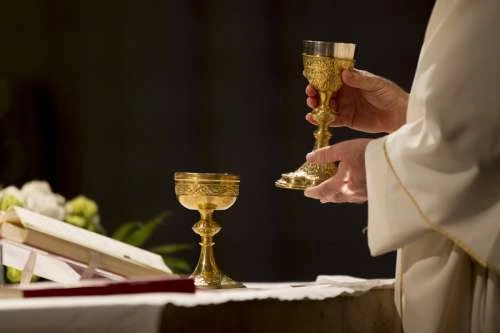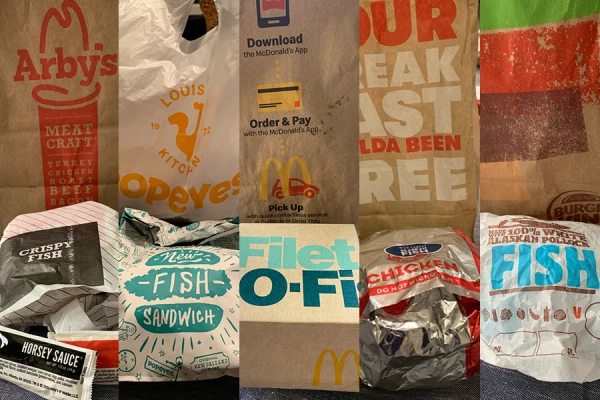
Washington D.C., May 29, 2020 / 12:56 pm (CNA).- The Trump administration has removed guidance on the Centers for Disease Control and Prevention (CDC) website which discouraged, among other things, singing, choirs and “shared cups” at religious services.
Despite the CDC’s backtrack, Catholic medical professionals and other experts with whom CNA has spoken continue to recommend that singing and the Communion cup ought to be discouraged at Mass for the time being.
Religious communities should “consider suspending or at least decreasing use of a choir/musical ensembles and congregant singing, chanting, or reciting during services or other programming, if appropriate within the faith tradition,” the guidelines, posted May 22, originally read.
“The act of singing may contribute to transmission of COVID-19, possibly through emission of aerosols.”
CNA learned from a person familiar with the deliberations that the White House did not approve the original CDC guidance before it was published.
That guidance was reportedly met with concern by many people of faith for certain provisions that seemed to intrude on the autonomy of religious groups, such as one recommendation that Jews should be allowed to use electronic devices on the Sabbath to stream services online.
A new CDC guidance page went live May 23. The new guidance, CNA was told, was to have the input of lawyers with experience in religious freedom cases. It was to be more sensitive to the autonomy of churches and religions and apply a “lighter touch” to them, functioning as a set of recommendations rather than instructions, and implying that actions taken by state and local governments that go beyond the federal recommendations are inappropriate.
The new guidance page contains no specific guidance related to singing or choirs. A recommendation to suspend the use of “shared cups” and passed or shared objects such as collection plates also was removed in favor of a recommendation to “clean and disinfect” such objects between uses.
The Washington Post, citing anonymous administration officials, has reported that the White House pushed against the CDC issuing guidance for churches, with the concern that it did not want to unnecessarily limit their freedom under the First Amendment.
The new guidance states at the top that it is not “intended to infringe on rights protected by the First Amendment to the U.S. Constitution or any other federal law.”
It goes on to say that the federal government may not prescribe standards for interactions of faith communities in houses of worship, and that in accordance with the First Amendment, no faith community “should be asked to adopt any mitigation strategies that are more stringent than the mitigation strategies asked of similarly situated entities or activities.”
As the novel coronavirus spread in March, all U.S. Catholic dioceses curtailed public Masses to prevent the spread of the disease. However, beginning in mid-April, dioceses have begun resuming the offering of public Masses.
An April 28 document from the Thomistic Institute in Washington D.C., written by medical professionals, researchers, and theologians and distributed to dioceses by the U.S. bishops’ conference, recommends that singing at Mass ought to be discouraged.
The Thomistic Institute’s document also recommends that the Precious Blood ought not be distributed at Mass.
To date, dioceses that have developed Church reopening plans have called for suspension of distribution of the Precious Blood. The Catholic Church teaches that reception of either the host or the chalice is a complete act of Eucharistic reception.
The Thomistic Instutute’s website does state, however, that the guidelines “will be updated as the situation changes and as the WHO/CDC guidance changes.”
Deacon Tim Flanigan is a member of the Thomistic Institute’s working group, an infectious disease specialist who has battled Ebola outbreaks, and a professor of medicine at Brown University. Flanigan also told CNA that Catholics can return to Mass and the sacraments safely if they observe CDC protocols.
“The question is: can I follow the CDC guidance just as carefully, in each setting, in order to decrease transmission of coronavirus? Can I maintain safe distancing? Can I maintain good hand hygiene? Can I ensure that I am not ill?” Flanigan told CNA last week.
If CDC guidelines are followed, “There is no reason to prohibit church services when you don’t prohibit other gatherings,” Flanigan said.
“The CDC gives us that guidance to decrease the rate of transmission. It’s just as important that guidance be followed at a house of worship, as at a conference, as at any other gathering.”
An ad-hoc committee of seven Catholic doctors and medical school professors released on May 12 a plan entitled “Road Map to Re-Opening our Catholic Churches Safely.”
That group of doctors concluded that “choirs and singing should be avoided” due to the aerosol risk.
They also concluded that the safest recommendation is to receive Communion in the hand rather than on the tongue. The plan does not contain specific guidance on the use of the cup at Mass.
The doctors’ plan calls for Mass to be held with social distancing, and for the use of masks and hand sanitizer. Those who are ill or believe they may have been exposed to the virus should stay home, it says.
Churches have been the focus of concern during the epidemic because of the close proximity of church attendees, socialization before, during and after services, and singing. Some churches have older congregations and so are believed to be more vulnerable to extreme consequences from coronavirus infection.
A May 22 article from the CDC reported that among the 92 attendees at a rural Arkansas church, 38% developed a laboratory-confirmed case of infection after a pastor and his wife, who had the virus, attended several events there in early March.
Twenty-six additional cases— including one death— in the community also were linked to the church.
The CDC had also, earlier this month, released a report chronicling a COVID-19 “superspreader” event, whereby a single symptomatic person infected more than 50 people— two of whom died— at a choir practice in Washington state in March.
Deacon Robert Lanciotti, a microbiologist and the former chief of the Center for Disease Control and Prevention’s diagnostic and reference laboratory in Fort Collins, Colorado, told CNA that in his opinion, the Washington state “superspreader” example does not entirely exclude the possibility of singing in church.
“The key issue here is that a symptomatic individual practiced for 2.5 hours in close contact with others with no facial coverings,” Lanciotti pointed out.
That individual also engaged in close-contact activities such as eating and talking, he said in an email to CNA.
“I think that it is likely that this individual infected others primarily by singing in close contact with others. However, it may still be safe to sing in a church in which symptomatic people stay home and those present are wearing masks.”
If you value the news and views Catholic World Report provides, please consider donating to support our efforts. Your contribution will help us continue to make CWR available to all readers worldwide for free, without a subscription. Thank you for your generosity!
Click here for more information on donating to CWR. Click here to sign up for our newsletter.





Leave a Reply